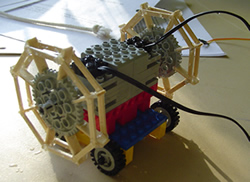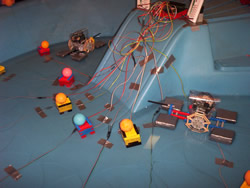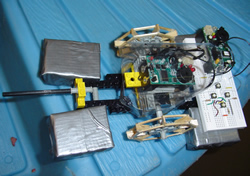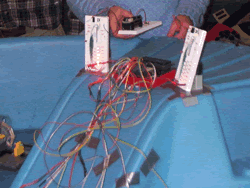| We knew from the beginning that we wanted to do something with water, because it is fun and adds a tremedous coolness factor. So we thought we would make boats, and power them with water wheels like ferrys. So what should we have boats do? We considered building a colosseum and re-enacting sea battles, and then we thought we might make an obstacle or slalom race course. Finally we decided to build a modified water polo game where the vehicles (which would be decorated as cute rubber duckys) would be in charge of reloading their landed catapult with ping-pongs, and also of defending their own goal with the stop sign on their backs. In the end however, the catapult re-loading mechanism was too difficult, and so we revised the game (but kept the name) to its current form. |
 |
| The duckys are distinguished by their colors: one is the yellow-and-black team, while the other is the red-and-blue team. In the pool, there are six towers belonging to each of the two teams, and the game starts off with a ping-pong on each tower, for a total of 12 ping-pongs. The goal of the game is for the ducky to knock all six ping-pongs off his towers before the opponent team does. The order of the ping-pongs does not matter. The duckys are equipped with jousting sticks in front, and are maneuvered by the players with remote controls, one for each duck.
For each ping-pong knocked off, one more light on the row of lights on the scoreboard for that team will light up. When one team wins, a random string of notes will be played and the scoreboard for that team will flash. To play again, all the ping-pong balls need to be replaced on the towers, and the "start" button on the main piece of hardware (the HandyBoard) needs to be pressed. |
 |
|
Duckys: Floats by four silver pieces (styrofoam), and is powered by two water wheels, one on each side. The jousting stick attached to the front is used to knock off ping-pong balls. A duck bill and two eyes from the battery connections of the computer chip (the Cricket) forms the face of the duck. The infrared receiver which receives the signal from the remote control is located on the back of the ducky, on the computer chip. The plastic sheet serves as a raincoat for the computer chip and the LEGO motors, protecting them from the splash caused by the water wheels.
Remotes: There is a remote specific to each duck, and can be used simultaneously without any interference to the each other or confusion on the duckys' part. The team color for each remote can be determined by the colored wire (red for the red-blue team, and yellow for the yellow-black team) in the top right corner of the remote when held with the computer chip pointing up. The signal is sent from the front end of the computer chip (the Cricket) and the four buttons on the lower half of the remote serve to move the duck forward, backward, left, and right in the same directions the buttons are placed.
Scoreboard: There are six lights on each of the scoreboards, representing the score of each team. A team makes a score by knocking off a ping-pong, which can be done in any order. When a team wins, the scoreboard of the winning team will flash to indicate victory, and when game is reset, will start off with all the lights off.
Towers / Ping-pong balls: The towers are all colored to indicate which team it belongs to, and each has a little indentation to hold the ping-pongs. The towers are all dispersed around the pool, so that the ducky will need to move throughout the entire pool to get to all of his six ping-pongs. The ping-pong balls are to be considered all identical, and it does not matter which tower a ball stands on.
|



 |



